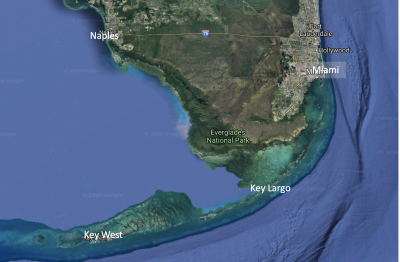The 4 Realities of Retreat: Florida Keys as an Example

Key Largo, Bayside. (Photo: Englander)
“The R word” – is so sensitive that in some circles it is not even discussed. Retreat inland from the coasts due to rising seas and short-term flood-events is an extremely contentious and emotional issue. A visit to the Florida Keys last week was a good time for me to consider the realities of retreat, though the concept applies to all low-lying coastal areas from Annapolis to Vancouver, from Copenhagen to Calcutta, and from the Bahamas to Bangladesh.
From Key Largo all the way down to iconic Key West, the Florida Keys are unique. “The Keys” are a chain of islands connected by bridges beginning just an hour south of metropolitan Miami, yet truly seem like another world. They have a rustic, island charm combined with ruggedness and rusting vehicles. However, the real appeal is not the islands themselves, but the sea: the multi-hued blue-green surrounding ocean that welcomes all manner of watersports particularly scuba diving, snorkeling, fishing, and sailing. They evoke the remote islands of the Bahamas, Turks and Caicos, and Caribbean where I spent a good part of my life.
While the grave challenge of rising sea level and retreat is not limited to the Keys, they are a good location to put the futuristic threat into practical realism. A common misconception or myth is that there is a certain water level or year at which point people will generally abandon vulnerable coastal areas. That’s not what will happen at all. Rather I think four characteristics better define the realities of retreat.
- Retreat will vary greatly. The allure will endure. Even with worsening flooding, many people will live in and visit the Florida Keys for a long time. Some will leave, but many will linger. I can well imagine people visiting the Keys into the second half of this century, perhaps longer.
- Causes of flooding tend to get confused. While water will gradually get higher from rising global sea level, the more imminent problem is flooding from extreme high tides; weather systems, including hurricanes; and heavy rainfall. It is hard to distinguish the different types of flooding. Instinctively our concern is for the big flood events, not the creeping rise of sea level which proceeds like a drip filling a barrel.
- Property Values will adjust downwards – in fact it’s already happening. Properties that flood more often are already being discounted compared to those that do not. The process will continue. Some who cannot afford or simply do not want the loss in asset value, have already sold out. Others will stay as long as possible, accepting the uncertainty and risk.
- Not just location but elevation. In real estate, there is a long-held axiom that the three most important characteristics of a property are: location, location, and location. In flood-vulnerable areas, at least one of those will become elevation. For decades in the Keys, building codes have required that new or renovated structures be designed to allow for severe short term flooding such as from hurricanes, which regularly visit the region. Living areas and critical equipment are elevated to be resilient to sudden flooding.

The ultimate problem is best seen in the challenge of maintaining the roads. Though there is only one primary road, the hundred or so miles of “US 1” that traverses the entire Keys, secondary streets comprise thousands of miles to maintain. Last week the US Army Corps of Engineers proposed a controversial $5.5 billion dollar plan to make the Keys more resilient to storms. It would involve elevating thousands of homes and buying out 300 for demolition. Resistance was immediate.
The tale of retreat was even clearer at a meeting last December, held in Key West. Sober warnings of the future became crystal clear, as reported in the New York Times. The County announced that it did not see how it could maintain some roads in the face of the rising sea. As an example, on Sugarloaf Key, near Key West, three miles of a secondary road that accesses less than two dozen homes now floods at extreme high tides. By the year 2025 the maintenance and rebuilding cost to keep the road dry is estimated to be $25 Million, more than a million dollars per home. By 2045, the figure rises dramatically to $128 Million and by 2060, $160 Million. The County put the residents on notice that it was impossible economically and therefore, unsustainable. Reactions from homeowners ranged from anger to acceptance. Perhaps some will fight in court. Others will tolerate vehicles rusting out ever quicker. Perhaps others will accept that their house is an island and travel by boat in place of the road that will eventually be abandoned. These are the realities of retreat. The rising sea will continue to rise.
Nonetheless, for many years to come, I expect to visit and enjoy the Keys.
